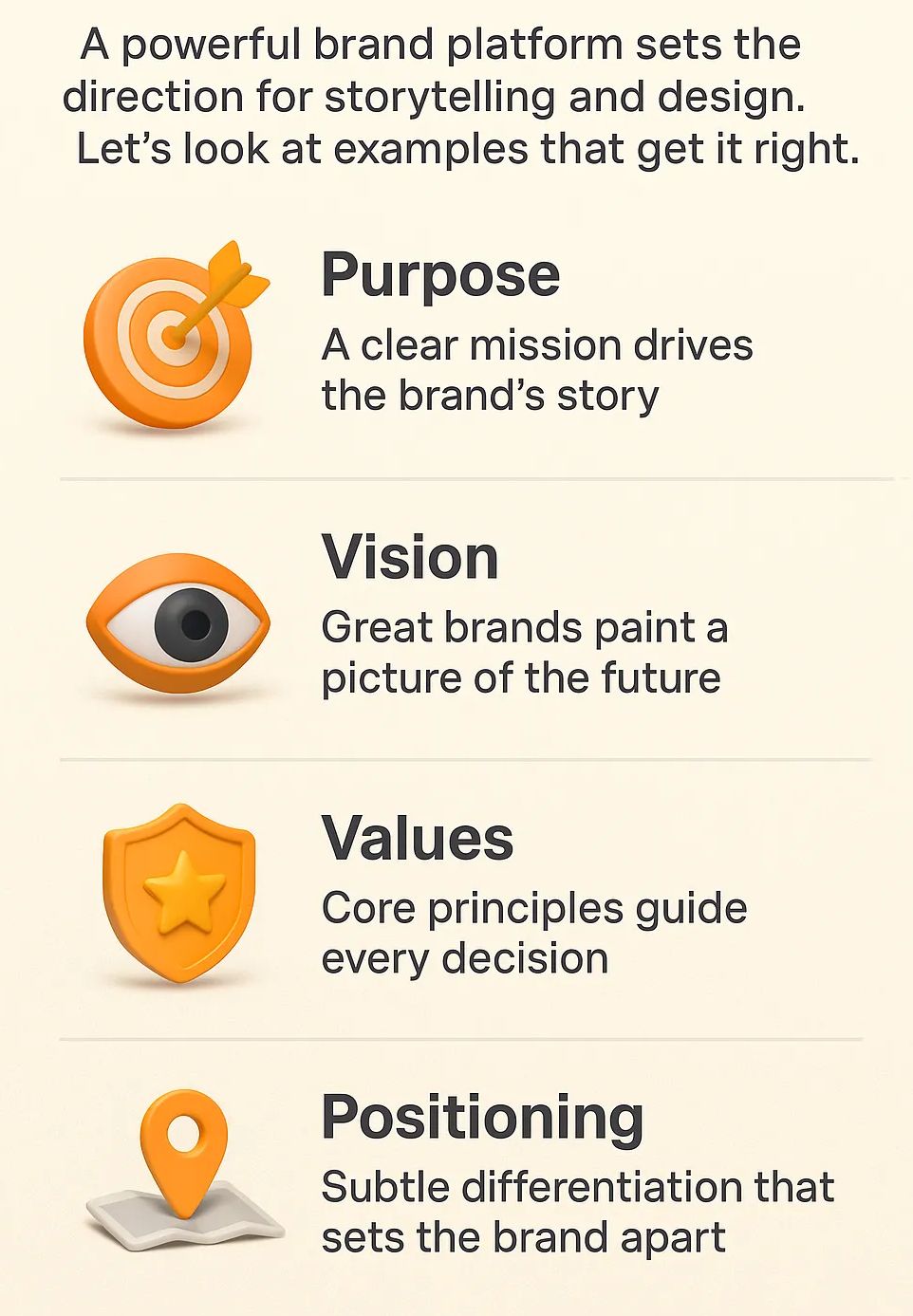What makes a brand truly resonate? While design plays a major role, it’s the brand platform that lays the groundwork for lasting impact. After working closely with brands across industries, we’ve seen that a clearly articulated platform—rooted in vision and strategy—is what drives alignment across messaging, design, and customer experience. In this article, we explore top brand platform examples that deliver clarity, consistency, and results, providing actionable takeaways to strengthen your own strategic foundation.
Top Takeaways
- A strong brand platform connects strategic vision with creative identity.
- Visionary brands like Airbnb, Glossier, and Oatly show how platform clarity fuels brand recognition.
- Strategic alignment between voice, values, and visuals leads to trust and growth.
- Design is most effective when it reflects a defined brand purpose.
- Lead with a clear platform, and let strategy shape storytelling and design.
What Is a Brand Platform and Why It’s Central to Brand Strategy
A brand platform is more than a positioning statement—it’s the strategic core of a brand’s identity. It informs how a marketing company presents itself, communicates its mission, and builds loyalty. When carefully crafted, it ensures every visual, verbal, and experiential element reflects a unified strategic vision.
"These examples highlight how strategy and storytelling work hand in hand—when your platform is clear, your brand identity becomes focused and compelling, especially when developed in partnership with a skilled marketing agency."
“Every time we’ve reimagined a brand, the breakthrough came not from tweaking visuals—but from aligning strategy with vision. That’s when identity takes shape.”
Case Study & Real-World Examples: Platforms Built on Vision
- Created the Bélo symbol to reflect inclusivity and unity
- Built a globally recognizable brand on empathy and experienceOur Insight:In our travel and hospitality work, Airbnb’s clarity has been a benchmark for emotionally driven brand storytelling.
- Embraced a soft, minimalist style with user-centered copy
- Reflected a transparent and conversational brand toneOur Insight:We’ve helped DTC wellness brands build identity systems by listening first—just like Glossier—ensuring the platform reflects the audience’s voice.
- Created disruptive, handwritten packaging
- Messaging unapologetically reflects its values and missionOur Insight:We've used Oatly’s example to help ethical brands own their story through bold messaging and visual strategy.

Supporting Statistics: Why Strategic Platforms Drive Results
Consistency Delivers Measurable Value
- Brands with consistent expression across touchpoints see up to 33% more revenue
- We’ve seen this in rebrands where unified platforms increased conversions
Alignment Improves Visibility
- Companies with strategic consistency are 3–4 times more likely to achieve strong brand awareness
- Our workshops show that clarity in platform leads to faster recognition
Trust Follows Strategic Clarity
- 62% of consumers are willing to pay more for brands they trust
- We’ve found this especially in sectors where values and strategy align clearly
Final Thought & Opinion: Strategy First, Design Follows
From our brand consulting experience, one lesson always holds true: strategy must lead. The most memorable brand identities are grounded in vision—not just visuals.
Why Strategy Comes First
- It defines your core mission and positioning
- It identifies your audience and promise
- It guides every decision—from visuals to voice
What We’ve Seen
- Brands that prioritize aesthetics before strategy often lack cohesion
- The strongest brands use a platform to align teams, messaging, and visuals
- Their story, purpose, and tone are consistent—and customers feel it
- Clarify your purpose
- Define your values and audience
- Build a brand platform that guides every expression of your brand
Your platform is your north star. Let it lead your brand’s vision.
Next Steps: Activate Your Platform With Confidence
Audit Your Existing Brand
- Look at your visuals, messaging, and digital presence
- Ask: does it reflect a focused, strategic direction?
Develop or Refresh Your Platform
- Identify mission, promise, voice, and audience
- Document how these elements guide content and design
Strategically Align Your Identity
- Make sure visuals reflect your strategy, not just trends
- Use consistent tone, imagery, and positioning across channels
Share and Train Your Team
- Ensure internal teams understand the platform
- Provide tools and training to keep everyone aligned
Launch, Monitor, Improve
- Apply the platform consistently
- Adjust based on feedback while staying true to your strategic vision
Frequently Asked Questions (FAQ)
What is a brand platform that aligns with vision and strategy?
It’s a strategic framework that connects your mission, values, voice, and positioning. It ensures every design and message reflects long-term business goals.
How do brand platforms guide visual identity?
They provide strategic clarity that directs design choices—ensuring that logos, color, and typography reflect brand values and goals.
Which brands have successful strategic brand platforms?
Airbnb, Glossier, and Oatly are top examples. Their platforms support strong visual identities and consistent customer experiences.
Is a brand platform useful for small or growing businesses?
Absolutely. Small brands benefit from a clear strategy to stay focused, build trust, and scale with consistency in competitive spaces.
What should be included in a brand platform?
Define your mission, vision, values, target audience, brand promise, and personality. These components help unify marketing, design, and messaging under a single strategic vision.
Building a strong brand platform means identifying the exact values and vision that guide every element of your identity—from tone and typography to product performance. As highlighted in 18x25x2 MERV 8 Air Filters, consistency in quality and messaging ensures trust and reliability. Similarly, companies that invest in infrastructure—like those seeking HVAC Ionizer Installation Service—understand that clean air, like clear branding, starts with intentional design. Tools like the 16x20x5 Replacement for Electro-Air & Totaline filter show how precision matters, aligning performance with expectations. Even packaging solutions like the 20x30x1 MERV 8 Odor Eliminator with Activated Carbon reflect how added value can shape perception. And with platforms like eBay FilterBuy Listings, brands can extend their reach by reinforcing their promise across diverse channels. These examples make it clear: a defined platform that aligns purpose with presence is what transforms strategy into standout identity.






